06 Jul The 3 Types of SEO Reports You Should Be Building in 2020 via @Supermetrics
This is a sponsored post written by Supermetrics. The opinions expressed in this article are the sponsor’s own.
SEO reports come in many shapes and sizes, which is why it’s important to start building yours with a clear goal in mind.
Do you want to:
- Track your website’s organic visibility in the SERPs?
- Get content ideas?
- Identify ideas for paid search campaigns?
- Figure out which link-building tactics have been generating the best results?
In this post, we’ll walk you through three must-build SEO report types that will help you stay competitive in 2020 and beyond.
Report #1: Website Health Audit
Before you do anything else, you’ll want to understand your website’s overall health in terms of on-page SEO (internal) and referring domains (external).
This report will function as the foundation for the following report types.
Pro tip: You can use Supermetrics’ SEMrush, Ahrefs, or Moz connectors to run this audit.
Website Overview (Internal)
First, create a new spreadsheet for tracking changes in your domain and page authority.
This will help you see progress over time.
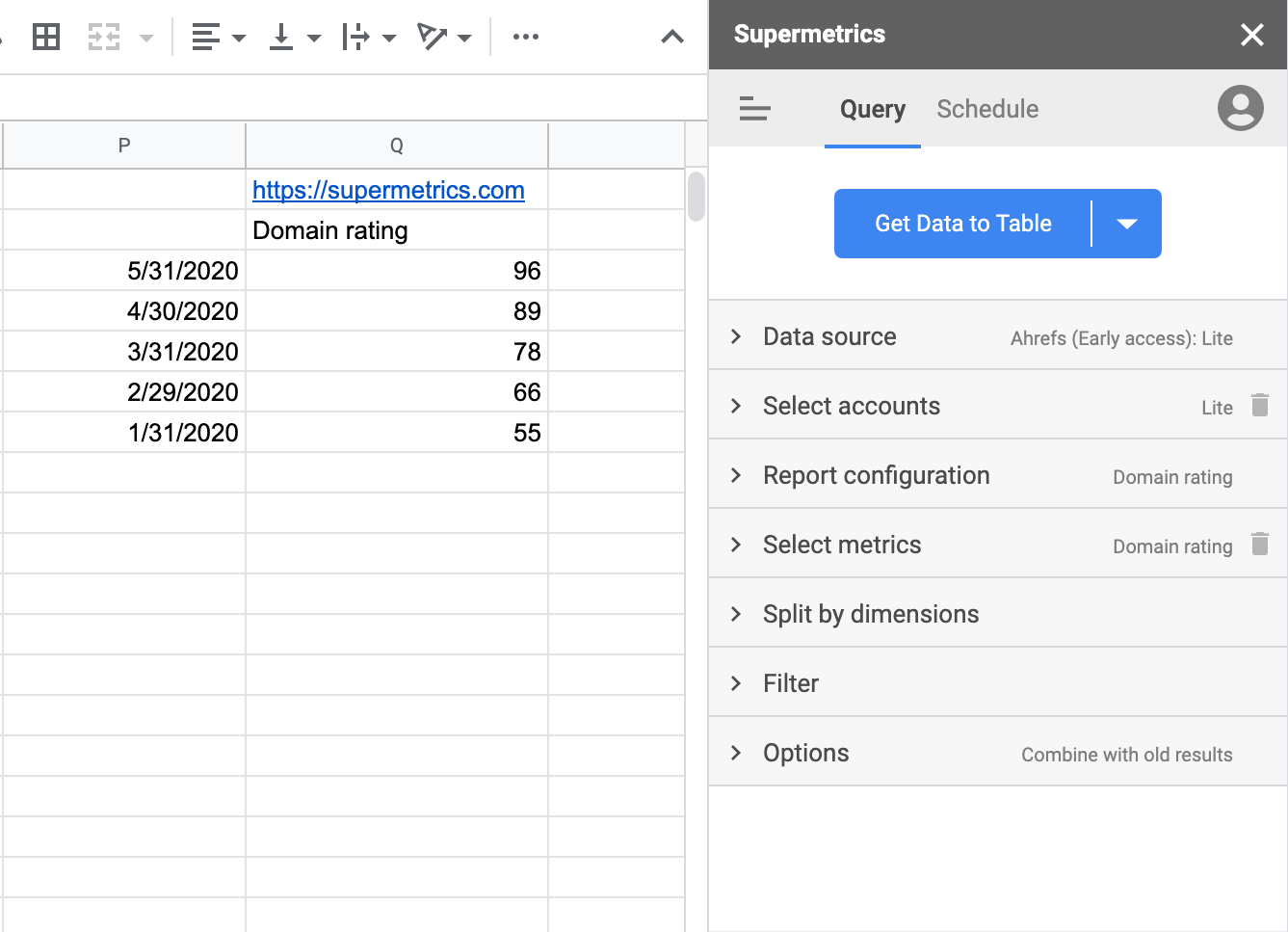

Next, create a breakdown of your key pages and their SERP positions.
This will help you identify the pages that require attention.


Finally, you’ll want to create an overview of all the domains you’re currently linking to.
Here, you might want to track the following metrics:
- Domain authority.
- Unique page count.
- Domain type (typically it’s better to link to government or education domains as sources).
- Link type (nofollow vs. dofollow and/or text vs. image).
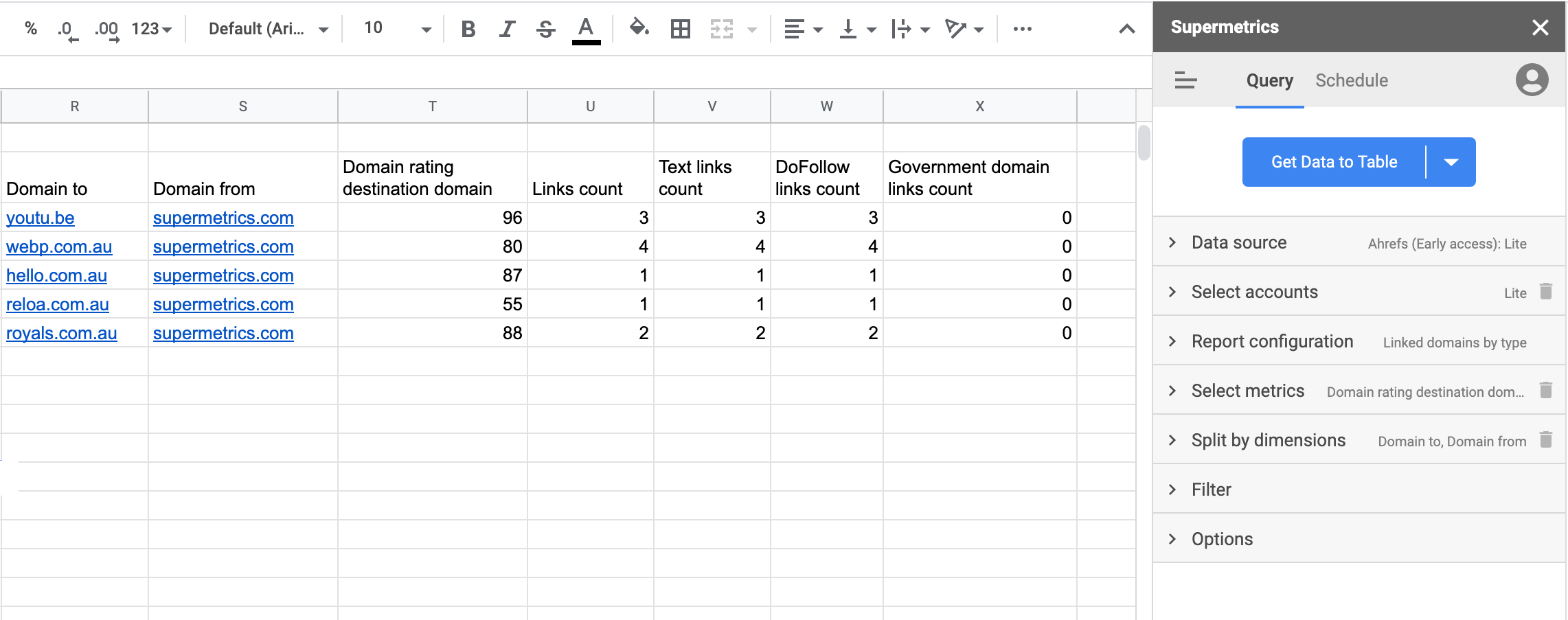

After you’ve audited your own domain, it’s time to take a look at the domains that are linking back to you.
Backlink Overview (External)
This report will help you see which domains link back to your website.
From there, you can identify opportunities for backlinks.
In addition, you’ll see what kind of content external sites find valuable, which allows you to adjust your content strategy accordingly.
First, pull together the total number of referring domains, pages, and backlinks for each of your key pages.
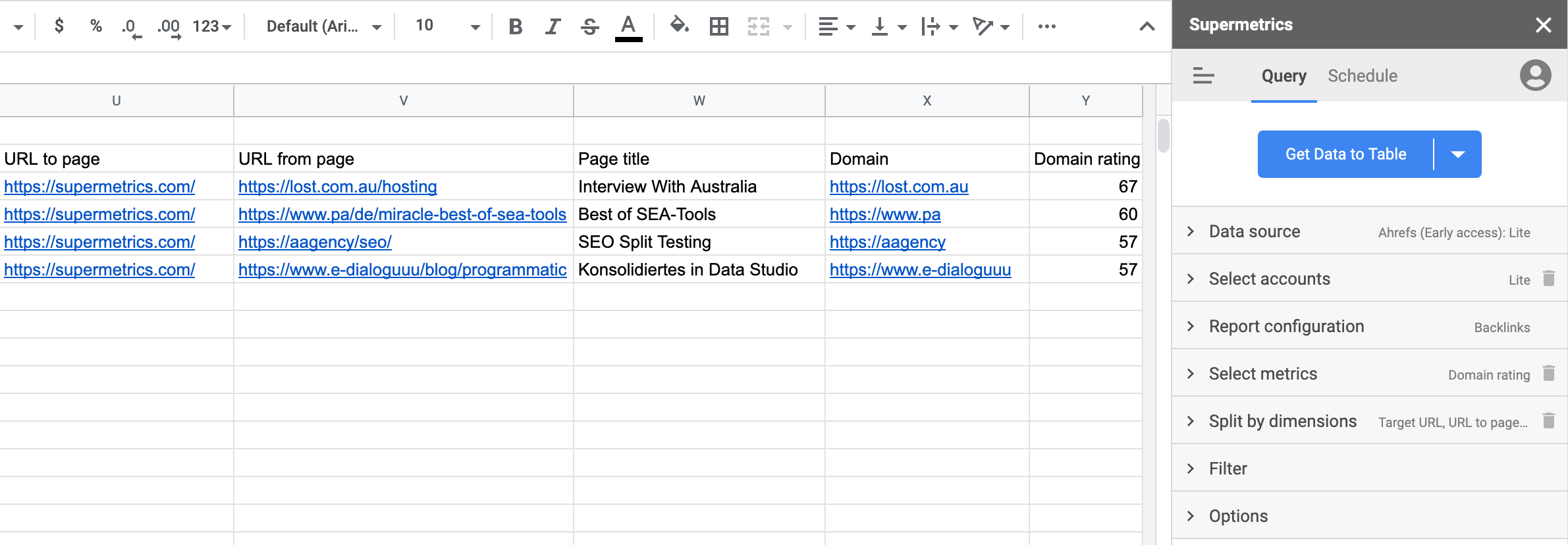

After that, analyze how many backlinks you lost or gained over time, and from which domains.
You can also go more granular here and create a breakdown of links to see the exact URLs of the external domains that link back to your site.
Another helpful breakdown is referring domains by country, which helps you see the geographic regions that are linking back to your site.
In case you notice a large number of links coming from a specific location (e.g., Spain), you might want to consider creating some content in Spanish or focusing your backlink outreach activities on Spanish people and businesses.
Additionally, pulling the anchor text of your backlinks will help you understand the context of the backlinks you’ve gained.
Finally, it’s good to report on the first/last seen date to track how fresh the backlinks actually are.
If no one has clicked on them during the past month, perhaps you could offer a more relevant backlink instead?
Get Detailed Information About Your Website Pages
To complete the health audit, add more data about your website pages that have backlinks.
First, check Google Search Console to make sure all of them are indexed on Google.
After that, check the source URLs to make sure they haven’t changed.
If the URLs have changed, pay attention to the response code and set up redirects if needed.
Here’s an example of what your backlink breakdown might look like in Google Sheets:
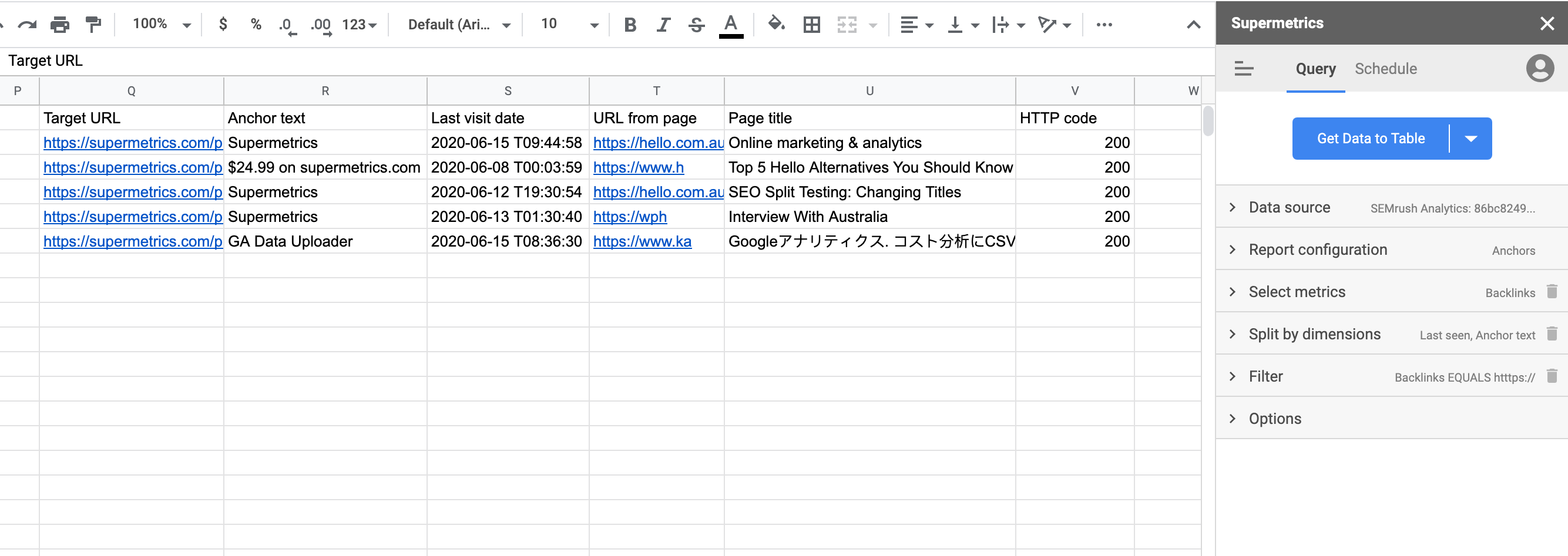

Report #2: Paid Search & Organic Keyword Opportunities
After you’ve analyzed your website’s overall SEO performance, you can move on to the next report:
Identifying keyword opportunities for SEO and SEM.
SEMrush is one of the best data sources for this report.
Run a Paid Keyword Audit
First, let’s identify your website’s top keywords, check how much traffic these keywords are bringing in, and see which website pages these keywords are leading people to.
Next, check what your keywords’ paid search positions are.
This will help you evaluate the competitiveness of your current keywords.
If you’re using SEMrush, you can also check your own and your competitors’ ad text copy along with ad performance. This will help you spot:
- Popular keywords to be used in paid search ads.
- The traffic volume is that’s brought to your website via paid search ads.
Based on this information, you can see whether there are some keywords you can outbid.
You might also want to start creating content around high-performing keywords to get more organic traffic.
If you’re using Google Search Console and Google Ads, you can build a report that shows the following for each keyword:
- Organic search vs. paid search clicks.
- Paid search CTR and conversions.
- Organic search ranking.
This data will help you see how much each keyword/search phrase relies on SEM.
If the reliance is high, you might want to create more content around these keywords to get more organic search traffic.


If you want to learn more about this report and get a nifty Google Sheets template for it, head over to this post.
Get More Keyword Ideas for Your Content
SEMrush, Moz, and Ahrefs are all great tools for finding new content ideas.
First, you can pull your keywords’ organic and paid results along with their respective domains and URLs. This data alone can provide you with a ton of ideas on what to write about.
If you’re using SEMrush, you can also see the keyword’s ad history to get more ideas for your content and/or ad copy.
Alternatively, you can use a more targeted approach here.
Simply select a competitor’s domain and check what the top-ranking pages for a particular keyword are.
Next, create better and more comprehensive content that would rank better for a particular keyword.
Report #3: SEO Competitor Analysis
We’ve covered some examples of competitor analysis in the previous reports, but since this is such an important area, you should probably create a separate report with this data.
First, start with a general overview. Check your competitors’ domain authority, page authority, and number of backlinks.
Here’s an example of this report with data from Moz:
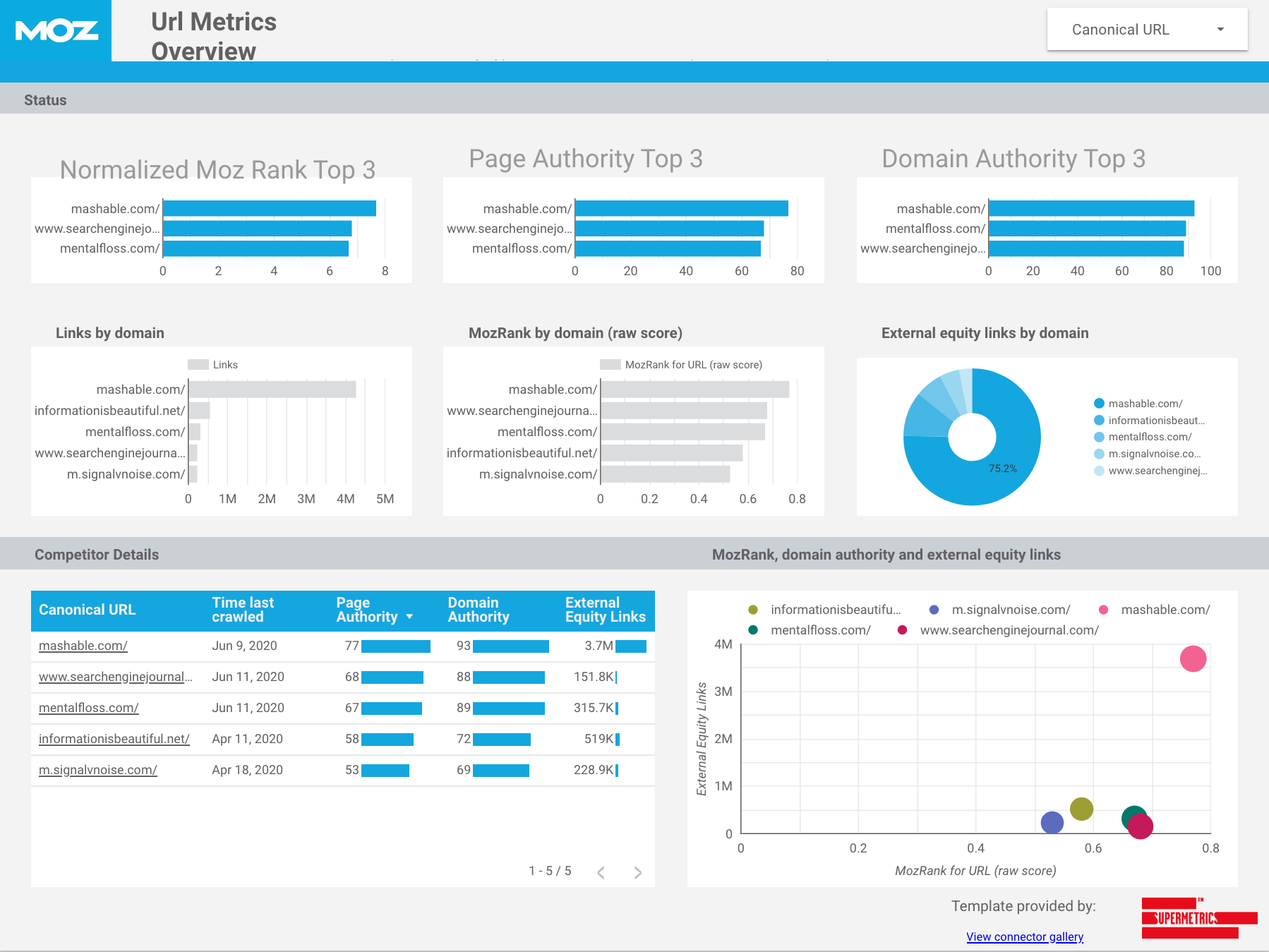

You can get this Data Studio report as a template for free from Supermetrics’ template gallery.
If you want to go granular, here are a few more ideas of what to include in your report:
- Which keywords your competitors are ranking for?
- What the traffic and CPC for each keyword is?
- What the competitors’ backlinks are and from which domains?
- Which domains are ranking for the same terms as you?
- What content/keyword gaps there are between you and each competitor?
- What your competitors’ best-performing paid ad copy is?
- What kind of content your competitors create to rank high for a certain keyword?
Start Building SEO Reports for Free
As you’ve probably noticed by now, a great SEO report should include data from many different sources.
You can use Supermetrics to pull all your data from Moz, SEMrush, Google Search Console, Google Ads, and any other marketing data source into a spreadsheet, Google Data Studio, your go-to BI tool, or your data warehouse.
Start your free 14-day trial of Supermetrics today.
Image Credits
Featured Image: Image by Supermetrics. Used with permission.
In-Post Photos: Images by Supermetrics. Used with permission.

Sorry, the comment form is closed at this time.